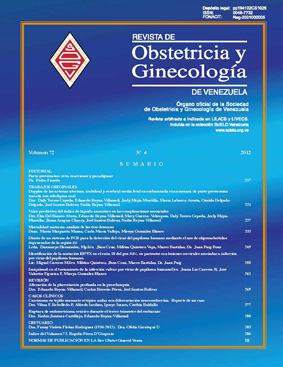Calcio sérico, grosor cortical del segundo metacarpiano y síntomas en la menopausia
Abstract
To establish the association between serum calcium concentrations, cortical thickness of the second metacarpal and symptoms of menopause.
Materials and methods: This study was cross-sectional and prospective and included menopausal women aged between 50 and 70 years who attended the Gynecology and Obstetrics consultation at the Central Hospital “Dr. Urquinaona”, Maracaibo, Venezuela. General characteristics, serum calcium concentrations, cortical thickness of the second metacarpal and menopausal symptoms were evaluated.
Results: Most of the patients (55.5%) were older than 65 years, with the onset of menopause after 45 years (64.8%), with 4 or more pregnancies (85.2%) and without a history use of contraceptive methods (79.6%). It was observed that 38 participants (70.3%) presented normal values of serum calcium concentrations, while 16 women (29.6%) presented values below the normal value and 28 participants (51.8%) presented moderate changes. and 6 women (11.1%) presented severe changes in the cortical thickness of the second metacarpal. When analyzing the possible associations between menopausal symptoms with both serum calcium values and cortical thickness values, it was observed that these were not significant (p = 0.5097 and p = 0.1617, respectively). No association was found between serum calcium concentrations and cortical thickness (p = 0.4074).
Conclusion: There is no significant association between serum calcium concentrations, cortical thickness of the second metacarpal and menopausal symptoms.
Downloads
References
Santoro N. Perimenopause: From Research to Practice. J Womens Health (Larchmt). 2016; 25(4):332- 339.doi: 10.1089/jwh.2015.5556. Bacon JL. The Menopausal Transition. Obstet Gynecol Clin North Am. 2017;44(2):285-296. doi: 10.1016/j.ogc.2017.02.008.
Yedavally-Yellayi S, Ho AM, Patalinghug EM. Update on Osteoporosis. Prim Care. 2019; 46(1):175-190. doi: 10.1016/j.pop.2018.10.014.
Lorentzon M. Treating osteoporosis to prevent fractures: current concepts and future developments. J Intern Med. 2019; 285(4):381-394. doi: 10.1111/joim.12873.
Duquet N. [Osteoporosis: risk factors and prevention]. J Pharm Belg. 2014; (2):4-12. French.
Levis S, Theodore G. Summary of AHRQ’s comparative effectiveness review of treatment to prevent fractures in men and women with low bone density or osteoporosis: update of the 2007 report. J Manag Care Pharm. 2012; 18(4 Suppl B):S1-15. doi: 10.18553/jmcp.2012.18.s4-b.1.
Terán Dávila J, Teppa-Garrán A, Febres C. Actualidad en el diagnóstico de la osteoporosis posmenopáusica. Rev Obstet Ginecol Venez. 2007; 67(2):115-125.
Terán Dávila J, Teppa-Garrán A. Actualidad en el tratamiento de la osteoporosis posmenopáusica. Rev Obstet Ginecol Venez. 2003; 63(3):135-148.
Barrionuevo P, Gionfriddo MR, Castaneda-Guarderas A, Zeballos-Palacios C, Bora P, Mohammed K, et al. Women’s values and preferences regarding osteoporosis treatments: A systematic review. J ClinEndocrinolMetab. 2019; 104(5):1631-1636. doi:
1210/jc.2019-00193.
Brinton RD, Yao J, Yin F, Mack WJ, Cadenas E. Perimenopause as a neurological transition state. Nat Rev Endocrinol. 2015; 11(7):393-405.doi: 10.1038/nrendo.2015.82.
Toffol E, Heikinheimo O, Partonen T. Hormone therapy and mood in perimenopausal and postmenopausal women: a narrative review. Menopause. 2015; 22(5):564-578. doi: 10.1097/GME.0000000000000323.
Robinson PJ, Bell RJ, Lanzafame A, Segal L, Kirby C, Piterman L, et al. Comparison of plain vertebral X-ray and dual-energy X-ray absorptiometry for the identification of older women for fracture prevention in primary care. Intern Med J. 2013; 43(1):38-45. doi:10.1111/j.1445-5994.2012.02930.x.
Ballane G, Cauley JA, Luckey MM, El-Hajj Fuleihan G. Worldwide prevalence and incidence of osteoporotic vertebral fractures. Osteoporos Int. 2017; 28(5):1531- 1542. doi: 10.1007/s00198-017-3909-3.
Jang S, Graffy PM, Ziemlewicz TJ, Lee SJ, Summers RM, Pickhardt PJ. Opportunistic osteoporosis screening at routine abdominal and thoracic CT: Normative L1 trabecular attenuation values in more than 20 000 adults. Radiology. 2019; 291(2):360-367. doi: 10.1148/radiol.2019181648.
Shioji M, Yamamoto T, Ibata T, Tsuda T, Adachi K, Yoshimura N. Artificial neural networks to predict future bone mineral density and bone loss rate in Japanese postmenopausal women. BMC Res Notes. 2017; 10(1):590. doi: 10.1186/s13104-017-2910-4.
Paschalis EP, Fratzl P, Gamsjaeger S, Hassler N, Brozek W, Eriksen EF, et al. Aging versus postmenopausal osteoporosis: bone composition and maturation kinetics at actively-forming trabecular surfaces of female subjects aged 1 to 84 years. J Bone Miner Res. 2016; 31(2):347- 357. doi: 10.1002/jbmr.2696.
Baccaro LF, Conde DM, Costa-Paiva L, Pinto-Neto AM. The epidemiology and management of postmenopausal osteoporosis: a viewpoint from Brazil. Clin Interv Aging. 2015; 10:583-591. doi: 10.2147/CIA.S54614.
Lee MK. Risk factors for bone loss in patients having clinical conditions that restrict physical activity. Rehabil Nurs. 2018; 43(1):12-20. doi: 10.1002/rnj.285.
Straight CR, Ward-Ritacco CL, Evans EM. Association between accelerometer-measured physical activity and muscle capacity in middle-aged postmenopausal women. Menopause. 2015; 22(11):120. doi: 10.1097/GME.0000000000000447.
Eitzen I, Hakestad KA, Risberg MA. Inter- and intrarater reliability of isokinetic thigh muscle strength tests in postmenopausal women with osteopenia. Arch Phys Med Rehabil. 2012; 93(3):420- 427. doi: 10.1016/j.apmr.2011.10.001.
Black DM, Rosen CJ. Clinical Practice. Postmenopausal Osteoporosis. N Engl J Med. 2016; 374(3):254- 262. doi: 10.1056/NEJMcp1513724.
Diab DL, Watts NB. Postmenopausal osteoporosis. Curr Opin Endocrinol Diabetes Obes. 2013; 20(6):501-509. doi: 10.1097/01.med.0000436194.10599.94.
Vidal M, Thibodaux RJ, Neira LFV, Messina OD. Osteoporosis: a clinical and pharmacological update. Clin Rheumatol. 2019; 38(2):385-395. doi: 10.1007/s10067-018-4370-1

